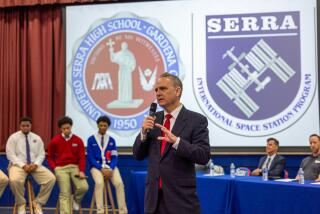POINT MUGU : Solving Challenges Old-Fashioned Way
- Share via
The 12-inch miniature rocket missed its target, a low-flying model airplane, by less than six inches, but the audience was impressed anyway.
It was as close as any of the teen-age participants in the second annual Science Challenge at Point Mugu’s Pacific Missile Test Center came Thursday to zapping the little plane out of the sky.
The problem assigned to the students was to calculate the math for a direct hit.
Those who weren’t launching rockets were tackling other problems just as perplexing, such as how to provide enough water for a fictitious Navy base proposed for a drought-stricken island off the California coast.
Not only did the 110 students have to be bright, they had to be quick. They were given only 75 minutes to solve their assigned problems.
But if anyone could do it, they could. There were math and science whizzes picked by teachers from six Ventura County high schools: Oxnard, Adolfo Camarillo, Channel Islands, Rio Mesa, Hueneme and Frontier.
After being divided into teams of three or four, they were briefed by Naval personnel about the problem assigned to them. They had received background information and helpful math equations before the competition.
Those in the rocket-launching group were given model rockets made of balsa wood and cardboard to assemble before the competition.
Then on Thursday they were given the problem: Calculate the angle of the rocket on the little plastic launcher so it would intercept the model airplane circling the field at 50 m.p.h. at an altitude of 50 feet.
No one made a direct hit, but Janell Mack and her teammates came the closest. Janell pushed the remote control button, and her rocket missed by inches.
“It was just luck,” said Janell, a senior at Adolfo Camarillo High School. But she said she spent a few lunch hours working on the math that went into the calculations.
“I love math and science,” she said, adding that she plans to major in engineering science next year at Cal Poly San Luis Obispo.
For the students plotting the water needs of the fictitious Navy base, the problem was one not only of water availability but of budget constraints.
They were allotted $615,000 and asked to figure out how to supply the base with enough water by using various water conservation systems, such as recycling and reverse osmosis. As part of their problem, they had to test various water supplies and determine which was best suited for what use.
“I realized how hard it is to do this and break even,” said Jessica Garcia, a student at Oxnard High School.
More to Read
Sign up for Essential California
The most important California stories and recommendations in your inbox every morning.
You may occasionally receive promotional content from the Los Angeles Times.













